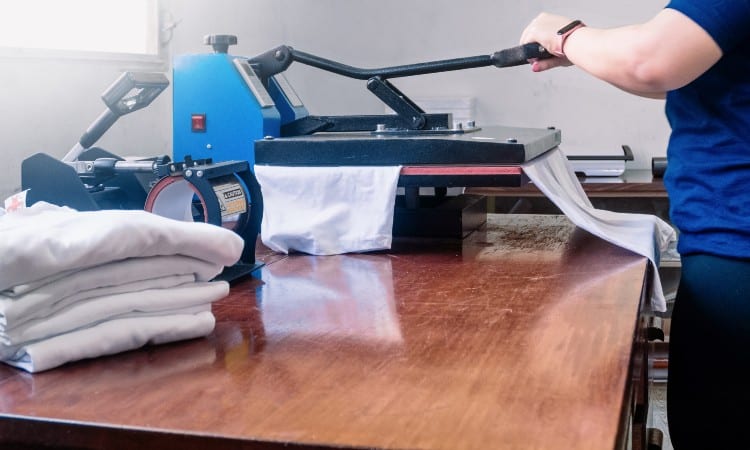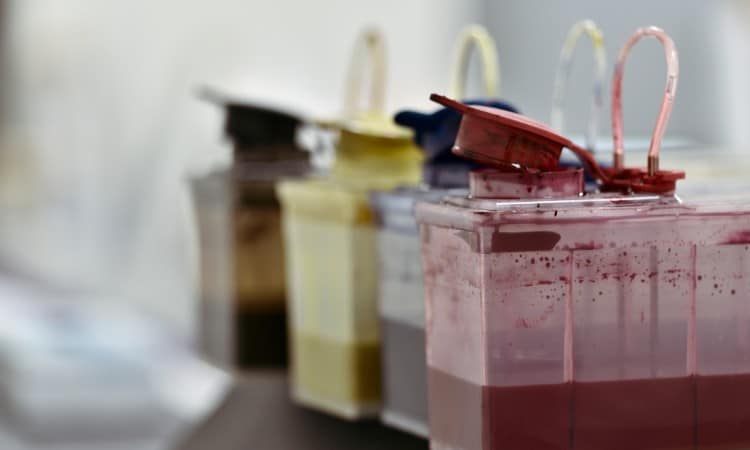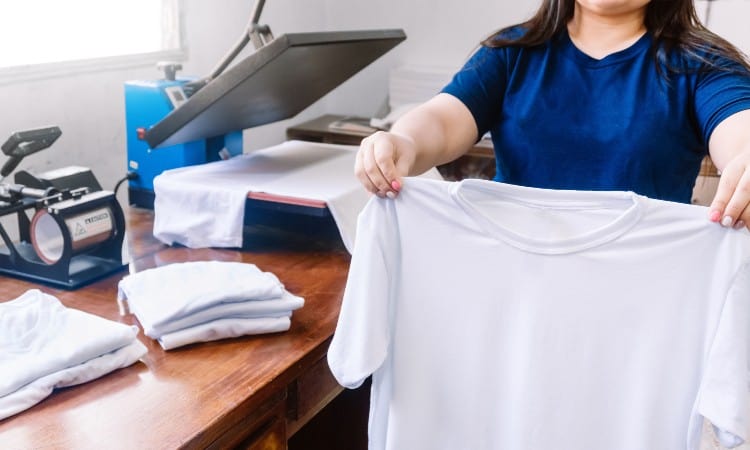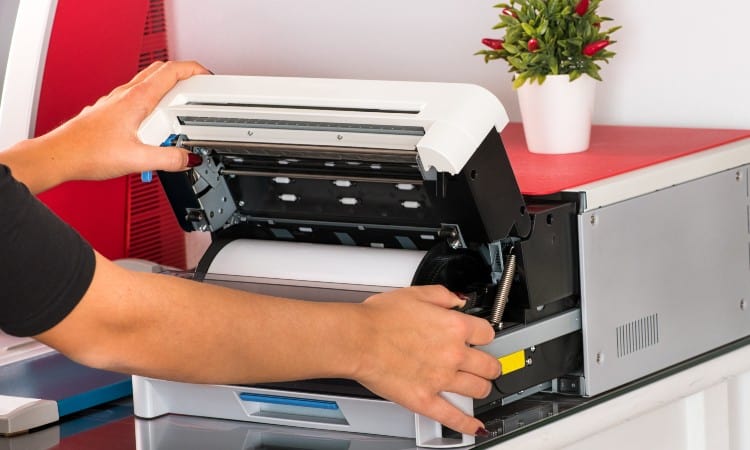If all your favorite t-shirts look worn out with cracked or faded designs, you may want to switch to sublimation printed shirts. This special printing method creates detailed designs that never wear out! Are you ready to learn how to do sublimation printing on shirts?
Sublimation printing uses heat-reactive dyes and high temperatures to turn the dye into a gas. The gas then bonds with the fibers of polyester fabric, creating detailed, permanent designs. This process requires sublimation dyes, a sublimation printer, polyester shirts, a heat press, and sublimation paper.
In this article, you will find out how sublimation printing works. You will learn how to make your own sublimation print on a t-shirt. Finally, you will find tips on the best printer and supplies to use for this process.

Quick Navigation
- What is Sublimation Printing?
- What Do I Need to Make Sublimation Shirts?
- How to Do Sublimation Printing on Shirts
- How to Sublimate on Dark Colors
- How Long Do Sublimation Shirts Last?
- What Is the Best Shirt for Sublimation?
- What Can You Sublimate On?
- Does Cricut Do Sublimation?
- Best Printer for Sublimation T-Shirts
- Companies That Offer Sublimation Printing
- Sublimation vs HTV T-Shirts: Which is Better?
- Conclusion
What is Sublimation Printing?
Sublimation printing uses a two-part process of creating a digital design in liquid ink on transfer paper and then applying that design to a t-shirt by using heat to turn the ink into gas. This method of shirt printing is rapidly gaining popularity because of its incredible durability.
This process does require some special materials, but it is also one you can master at home if you want to invest in a few pieces of equipment! Just like making HTV or screen-printed shirts, this is a method used by professionals but also accessible to home artists.
So, how exactly does it work? First, take a moment to remember a few basic science concepts.
Most objects can take three different states of matter: solid, liquid, or gas. Think of an ice cube. As you carry the tray to your tap and fill it up, the water has a liquid state. If you let it sit in your freezer overnight, it transforms into a solid when it becomes ice.
If you put the ice cube in a pot over a hot burner on your stove, the ice will melt back into a liquid state and then eventually heat up into steam or a gaseous state. Usually, a physical substance must go from solid to liquid to gas, in that order.
Sublimation means that nature’s regular rules get bypassed because this process turns a solid directly into a gaseous state without turning to liquid first.
Take a look at the basics of the printing process:
First, you use a graphic design program or download a digital image. You send this design to your sublimation printer, which uses the basic CMYK primary colors in special sublimation dyes to create any kind of image, no matter how detailed or elaborate.
The printer recreates this image onto special sublimation transfer paper. You then use a heat press to seal the design on the transfer paper to the fabric of the shirt.
Here is the cool part: the heat causes an interesting reaction in the sublimation dyes on the transfer paper. Heat turns this kind of dye directly into a gas, which infiltrates deep into the fabric’s fibers.
This process also depends on the pores of the fabric opening up when exposed to immense heat and pressure and then re-sealing as they cool, which encloses the dye particles even more securely. The gaseous particles form bonds with the fabric at a molecular level. In a sense, the dye and the fabric merge chemically!
Because the dye gets so deep into the fabric, instead of just sitting on its surface, and because of these strong bonds, sublimation printing is often seen as one of the most durable and advanced forms of shirt printing available today.
What Do I Need to Make Sublimation Shirts?

You need specialized equipment to create sublimation t-shirts, such as a sublimation printer, dyes, and transfer paper. While the initial investment may seem high, keep in mind that this type of printing is rapidly becoming the highest quality type of print on the market!
Let’s break it down to the absolute basics you need to get started with this kind of printing.
- To start with, you will need a sublimation printer. These kinds of printers typically cost anywhere from $200-$1,000, though if you like techy things, you can also convert an ordinary inkjet printer into a sublimation printer. This process gets a bit complex for the layperson, so most artists prefer to buy a printer designed to work with sublimation dyes, like this one.
- You can’t make sublimation prints without a heat press. Unlike other types of home printing, you cannot substitute your iron and ironing board for this, though you can use a small press like the CricutEasyPress if you only want to make small sublimation designs. More professional heat presses with larger surface areas can cost anywhere from $300-$3,000, but the investment is well worth it!
- You also need transfer paper coated in special chemicals that help the dye particles evaporate into a gas. Ideally, you will want to use a fairly thick paper that does not wrinkle easily, like this brand. The key thing to know about sublimation transfer paper is that you absolutely cannot use regular heat press transfer paper–you need paper designed for the sublimation process!
- Once you get into this process, you will also need dye refills. Because our sublimation printer uses the digital primary colors of cyan, magenta, yellow, and black, you can get refills pretty cheaply, like this!
- If you want to launch a t-shirt business, you will probably want to create your own proprietary designs. For this, you will need to master some form of digital design software, such as Adobe Illustrator or Inkscape.
- Last but not least, you will also need shirts to print on! You can find out more about this later on in this article, but for now, keep in mind that sublimation printing works best on 100% polyester shirts.
How to Do Sublimation Printing on Shirts

Once you have your basic supplies on hand, you can quite easily learn how to do sublimation printing on shirts! Just follow this step-by-step guide to get started.
Getting Started
Before you attach the printed design to a t-shirt, you need to do some prep work, such as preparing the surface of the shirt and downloading your design.
To get a shirt ready for printing:
- Use a heat press or an iron to create a smooth, flat surface where you plan to apply the design. Any wrinkles will create smudges and gaps in your design!
- If you have an EasyPress or another small hand press instead of a full clamshell-style heat press, make sure you have a clean, flat surface to work on as well.
- Keep a lint roller on hand. Use it on the shirt once now and again right before you apply the transfer paper. This is a key step because any fleck of fuzz or lint will add smears and blotches in your design.
- Place a piece of thick paper inside the shirt so that no dye bleeds through to the reverse side during the heat press step.
To prepare your design:
You can make this process as complex or simple as you choose. You can easily find and download many free graphics online if you want to use a read-made design. You could also use a digital photo.
Alternatively, you could design your own lettering or graphic using professional software like the Adobe Illustrator package or free online options such as Inkscape. Corel Draw is another popular paid option for creating unique, one-of-a-kind graphics for shirts. These programs require quite a bit of graphic design skills or a willingness to learn!
No matter what design choice you make, the key thing to know when choosing a design to apply to your shirt is the difference between raster and vector graphics.
Raster graphics are composed of thousands of tiny color dots or pixels. These images come in formats like JPEG, GIF, and PNG. They contain many pixels, so expanding or stretching them can make them look blurry.
Most photos use this format and can come in varying levels of digital resolution, described by how many pixels the image contains. A higher number of pixels will indicate a more detailed image.
Vector graphics use more complex lines, curves, and angles to create easily resized graphics. Designing a vector graphic does require some graphic design skills, but many artists prefer this style for their work because of its flexibility. These images will have formats like EPS, PSD, and JPEG.
Finally, keep in mind that you will place the transfer paper upside down on your shirt. This means you will need to “mirror” your design if it includes any text! You can easily find this function in most design programs.
Making a Print
Making a print on a shirt is the most fun part of sublimation printing! You get to see the magical part of the process come to life.
- Print your image or lettering onto sublimation transfer paper using your sublimation printer. The design may look duller than you expected, but it will get brighter as you apply heat later!
- Next, place your design ink-side down onto the fabric of the shirt. Make sure you place it straight down with no sliding or smearing. You may even want to attach the corners of the paper with heat-safe tape for added security.
- Next, smooth a protective Teflon sheet over the paper. Often this protective sheet will come with your heat press.
- Check the transfer paper package to determine what temperature to use on your heat-press. Usually, sublimation printing requires a temperature of 360℉ to 400℉.
- Apply the heat press to the Teflon sheet. If you have a clamshell-style press, you will close it and let it apply pressure. If you have an EasyPress or similar hand press, you will need to apply considerable force yourself.
- The timing will differ depending on the kind of sublimation paper you used. Most of the time, you will leave the design in the heat press for about 30 to 40 seconds, but check the paper package for specifics!
- Once you finish with the heat press, immediately remove the Teflon sheet and gently peel away the transfer paper.
- Check out your vivid design!
How to Sublimate on Dark Colors
While you cannot use sublimation printing directly onto a dark-colored or black fabric, you can learn how to sublimate on dark colors by using special vinyl sheets.
For this process, you follow almost all of the same steps as you would in your basic sublimation printing method. The biggest difference is that you will print the design directly onto a special sublimation heat transfer vinyl. You will then use your heat press both to sublimate the design into the HTV and to adhere the HTV to the fabric!
- Prep your design and shirt as described earlier in the article, with one exception: you do not want to mirror the image this time before printing, as you will print straight onto the HTV.
- Insert a sheet of sublimation HTV vinyl into your printer with the dull side up so that the ink will go onto the dull side. The backside has a shiny peel-away sheet that you will remove later. You cannot use regular HTV for this–you have to find special sublimation HTV that contains polyester, or the chemical bonding process will not work when the dye heats!
- Depending on the style of your design, you may want to use a Cricut or scissors to remove the excess vinyl from the design. For instance, if your print is in the shape of a cat, you may want to remove all the vinyl around the edge of the cat shape.
- Peel off the shiny back and place the HTV on the shirt.
- Apply your protective Teflon sheet and then heat press for 15 seconds at 360℉.
This is usually the easiest solution for sublimation printing on black fabric. The other option is to print a thick white layer onto the shirt as pretreatment and then apply the transfer design on top of that.
How Long Do Sublimation Shirts Last?
Sublimation prints will never wear out, discolor, or crack and peel, so a sublimation-printed shirt will last as long as the polyester fabric can hold up! The lifespan of a polyester tee depends on many factors, like how often you wash it, but usually, these shirts will still look bright and colorful after ten years of use.
The reason sublimation prints can last so much longer than other kinds of designs lies in the chemical bonding process that attaches dye particles in a gas state to the fibers of the fabric deep beneath eh surface of the shirt. Other design methods such as HTV or screen printed designs do have excellent durability, but both of these methods place the whole design on the surface of the shirt. Eventually, they will likely fade or crack.
What Is the Best Shirt for Sublimation?

The best shirt for sublimation printing is one made out of 100% polyester. Sublimation dye needs to bond with polyester to work properly. Using a shirt made of a fabric blend, such as polycotton, will often create slightly less vivid prints.
Sublimation printing does not work well on 100% cotton, though. The dye will wash right back out of cotton. If you like a softer or more stretchy t-shirt, try a tri-blend fabric that still contains a large percentage of polyester, ideally at least 75%.
The great thing about working with polyester shirts is that they often cost a lot less than all-natural fabrics like cotton. Plus, if you want to make and sell a lot of t-shirts, you can easily find polyester shirts for sublimations in wholesale quantities, lsuch as this one!.
What Can You Sublimate On?
You can sublimate on many surfaces besides polyester fabric, including ceramic, plastic, glass, and more!
The key to this process is that you need an item, known as a sublimation blank, coated with a special sealant containing polyester. You can then apply the sublimation design to that coating, and it will bond just as it does with polyester fabric!
You do have to seek out special sublimation blank items, though. You can’t simply apply sublimation transfer to any old mug, glass tumbler, or wooden puzzle. Plus, you may need special equipment like a mug press to apply heat to any 3D object.
Does Cricut Do Sublimation?
Cricut offers an alternative to sublimation that works in almost the same way by utilizing something called infusible inks. Cricut invented a chemical process that allows special infusible transfers to bond with the fabric, like sublimation dye bonds during its heating process.
This brand-new option does come with a few caveats. Cricut claims these infusible transfers will only work with special blanks that Cricut makes and sells.
To create these designs, you can cut out shapes from the special transfer and then use a heat press to bond the shape into the fabric. Or you can use Cricut’s special line of pens and markers to draw your own designs on the special transfer paper and then use the heat press. You do not actually print out a design in either of these methods, though–you simply utilize Cricut’s special infusible transfers.
Best Printer for Sublimation T-Shirts

The best printer for sublimation t-shirts is designed to work with sublimation inks and comes with important features like the ability to interface with both Windows and Apple computers. Every year newer and fancier models hit the market, but you can usually count on several prominent brands to deliver the best possible sublimation designs.
Sublimation printers for home use range in price from about $300 to upwards of $600, on average.
These include:
- Sawgrass has made a name for itself in the world of sublimation technology. For example, the Virtuoso SG500 printer offers bonus sublimation dye cartridges, transfer paper, and design software!
- Epson has consistently offered excellent sublimation printers for t-shirts. One of their newer models, the Epson Stylus C88 +Inkjet Printer Color 5760 offers a scanner and special photo editing options and the ability to work with sublimation dyes. The Epson ecotank et-4760 t-shirt printer also remains popular with home artists, though it does need conversion to sublimation dyes.
- Workforce offers a slightly more costly line of excellent sublimation printers, including the stunning Workforce WF-7710 Wireless color printer. This model comes with copy and scanning capabilities and a touch screen and advanced printing options.
Companies That Offer Sublimation Printing
If you want the high-quality option of sublimation printed t-shirts but do not want to invest in a printer, expensive dyes, and a lot of transfer paper, you can also consider outsourcing the printing process and simply applying pre-printed sublimation transfers to your shirts.
How does this work? You can easily find sublimation printing companies near you by Googling or seek out the best deal by comparing companies based anywhere in the world. Distance really doesn’t matter in a global economy!
Once you find a reputable company, you agree to a price and then send in your digital design. The company will use professional-grade sublimation printers to print out the design onto transfer paper and then ship the prints to you.
Once they arrive, all you have to do is use a heat press to sublimate the prints onto your shirts!
Many small business owners find this a more cost-effective way to get shirts ready for sale than doing all the printing work themselves.
Sublimation vs HTV T-Shirts: Which is Better?
Whether you prefer sublimation or HTV designs on a t-shirt depends on many factors, as both methods can deliver excellent results!
Sublimation printing has greater durability than heat transfer vinyl. This is because the sublimation process causes the dye to create bonds with fabric fibers deep below the surface while vinyl adheres to the top of the fabric.
On the other hand, vinyl works on all colors of fabric. As you now know, sublimation printing does not work as easily on dark or black shirts.
You also have to consider the cost of creating each kind of design. Getting started making HTV designs is extremely low-cost, though you can buy more expensive equipment like a Cricut to cut out the vinyl if you choose.
Sublimation printing does usually has a start-up cost of $500 to $1,000 by the time you purchase the special printer, dyes, and transfer paper.
Another benefit of using HTV designs is that you can use all kinds of specialty vinyl, such as glitter or metallic vinyl.
But the final, perhaps most significant, advantage of sublimation printing is that you can print intricate, highly detailed designs with great accuracy! Of course, while using vinyl, you have to cut out only one color of vinyl at a time and layer the colors if you want to use more than one shade. Sublimation printing allows you to easily create everything from lettering to full-color photos on the front of your shirt!
Conclusion
If you want a high-quality, long-lasting t-shirt design, you may want to try sublimation printing! This printing process uses a special dye that can turn into a gas and then bond with polyester fabric when exposed to high heat. You can create almost any kind of design, including full-color photos using this printing method, but it only works on polyester or fabric that contains a high percentage of polyester fibers.
Sublimation printing also requires a special printer, unique dyes that can transform into a gas and then bond with polyester fibers, and a specific kind of transfer paper. You will need a heat press to sublimate the ink and create the design on your shirt as well.
Have you ever used a sublimation printer? Did you like the quality of the design you created? Leave a comment below to let us know!